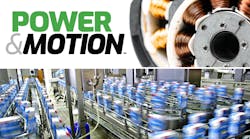In his final column, retired Hydraulics & Pneumatics editor and International Fluid Power Society’s Hall of Famer Alan Hitchcox looked to the future when he wrote, “Even though fluid power is a ‘mature’ technology, it certainly isn’t stagnant. The biggest news is the growing trend to power mobile hydraulic systems with variable-speed electric drives instead of internal combustion engines. Pneumatics is encompassing more diverse applications than ever, thanks, in part, to wireless and remote monitoring and control.”
I agree with Alan. Stagnation in the face of change is a path to obsolescence. Faced with the prospect of such change, the decision is a simple one. We have chosen to embrace change, and we will do it not by abandoning the legacy of the past, but by using that legacy as the foundation for the future.
In January, we will broaden our traditional coverages of pneumatics and hydraulics systems and strategies with expanded information on how those technologies are being integrated into modern electrical actuation and motion control solutions. The growth of these hybrid technologies, as well as a greater reliance on electric actuation, will be especially important as we contemplate a world of electric vehicles of all kinds. The growth in pharmaceuticals and food manufacturing also will require new solutions for motion control and the appropriate power sources to drive them.
I’d like to introduce Power & Motion. As a brand extension of our traditional coverages, Power & Motion is different in two important ways. First, we have reinvented Power & Motion as a multi-platform content resource that will include:
- An in-depth look at trends, strategies and best practices in motion control
- Industry-focused research
- Videos highlighting the top industry leaders and trends
- E-books focused on best practices across several disciplines
- Integrated social media channels
- Industry event and show coverage
- Product galleries focused on the latest innovations.
- Power & Motion magazine and its digital counterpart, to be published eight times a year
Regular readers of our digital products, particularly our global newsletter audience, should make sure to whitelist www.powermotiontech.com (set to launch on January 3, 2022) to ensure they will receive all of our content in the future. You will be receiving emails from Power & Motion in the next few weeks further discussing this change.
Our other big difference is our approach to this industry and its practitioners. In the dynamic future we envision, Power & Motion will provide a strategic review of the future of modern motion systems and their power sources—pneumatic, hydraulics, electrical and hybrid, as well as the hardware, software, training and maintenance needed to build a more productive and efficient system.
We were led in this direction by another visionary—Dr. Steffen Haack, now the CTO of Bosch Rexroth AG. Writing in Hydraulic & Pneumatics in 2019 as head of the company’s Industrial Hydraulics Business Unit, Dr. Haack saw the need to preserve hydraulics as an important component of a motion control system. He wrote, “How can hydraulics technology transition its image to the new world? The answer is simple; the dinosaur must adapt by integrating new technologies, especially electronic control and electromechanical power transmission. By doing so, hydraulics will metamorphose into a novel, high-tech experience for users.”
Dr. Haack added, “In specific terms, this means retaining hydraulics’ strengths and combining them with the opportunities and benefits found in the technical ‘IT consumer world.’ Users will then perceive ‘hidden’ hydraulics as a compact, finished functional module—simple, intuitive, connected and quickly installed. Regardless of this vision of the future, hydraulics must maintain its position against electromechanical drives.”
We see the future in the same way. As our new mission statement puts it:
Power & Motion provides a strategic review of modern motion system design and its power sources. P&M will cover pneumatics, hydraulics, electrical and hybrid technologies, as well as the hardware, software, training and maintenance needed to build and maintain a productive and efficient system. Content will focus on the emerging technologies to monitor and operate a modern motion system, including sensors and integrated smart systems, electrohydraulics, fluid power management, condition monitoring, operational costs and the importance of training and development.
The choice never will be one solution to the exclusion of the other, but each solution, with its own strengths and virtues, all helping engineers and plant managers achieve the highest levels of safety, efficiency, productivity and power management in a still-evolving global landscape.
And as that landscape evolves, we look forward to your contributions, suggestions, critiques and ideas as we work toward the future.

